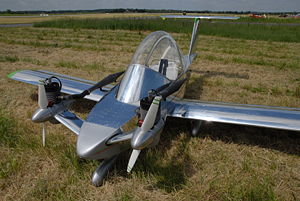- Colomban Cri-cri
-
Cri-Cri French-built homebuilt Cri-Cri F-PCLF at Air Expo 2007 Role Homebuilt recreational aircraft Designer Michel Colomban Introduction 1973 Status In civilian use The Colomban Cri-cri (short for cricket) is the smallest twin-engined manned aircraft in the world, designed in the early 1970s by French aeronautical engineer Michel Colomban. With a wingspan of 4.9 m (16 ft 1 in) and 3.9 m (12 ft 10 in) long, it is a single-seater, making an impression, at close range, of a dwarf velomobile with wings.
Contents
Design
The Cri-cri has superior aerobatic performance; capable of 1 roll per second. There are approximately 30 Cri-cri aircraft in airworthy condition in the U.S. and over 100 around the world as of 2003.[citation needed] <! supposition blanked Word of the mouth around the exhibit said that the designs are no longer available by the author's request, except as a personal favor to those home-builders that are his friends. However, the fan site below still lists his address, saying that, if you are not in North America, you might still be able to get a design. Also, occasionally, unfinished kit projects are sold, as with every other homebuilt design. -->
The MC-10 Cri-Cri has a cruising speed of 170 km/h (92 knots, 105.6 miles per hour) and a range of 750 km (466 standard miles, 405 nautical miles).[citation needed] The MC-12 model has a cruising speed of 185 km/h (100 knots, or 114.9 miles per hour) and range of 500 km (310.6 standard miles, 270 nautical miles). The MC-15 is powered by two 15 horsepower (11 kW) engines.
Variants
As with any homebuilt aircraft, the existing Cri-cri planes have often been modified by their builders, departing from the original design to a varying degree, resulting in different performances.
- one flying Cri-cri, F-PZPR, was equipped with AMT Olympus turbine jet engines, increasing the cruising speed to around 240 km/h (130 knots, 149.1 miles per hour).
- In June 2010, EADS Partnered with Aero Composites Saintonge and the Greencri-cri Association, presented a electric powered Cri-Cri at the Green Aviation Show in Le Bourget. The modified airframe with composite components can fly for 30 minutes at 110 km/h. The aircraft uses four brushless electric motors with counter-rotating propellers, which makes the aircraft one of the world's smallest four engine aircraft as well.[1]
- On September 5, 2010 Electravia accomplished a world record speed of 262 km/h (162.33 mph) for a lithium polymer powered aircraft using a Cri-cri with two electric motors (each producing 25 hp) during the attempt. The company claimed engine and cooling drag reductions of 46 percent versus the conventional combustion engine arrangement.[2]
- Kits for homebuilding have been sold by Zenair of Canada as the Zenair Cricket
Specifications (MC 15)
Data from [3]
General characteristics
- Crew: 1 (Pilot)
- Length: 3.9 m (12 ft 10 in)
- Wingspan: 4.9 m (16 ft 1 in)
- Wing area: 3.1 m2 (33 sq ft)
- Airfoil: Wortmann 21.7
- Empty weight: 78 kg (172 lb)
- Max takeoff weight: 170 kg (375 lb)
- Powerplant: 2 × JPX PUL 212 single-cylinder piston engines, 11 kW (15 hp) each
Performance
- Maximum speed: 220 km/h (140 mph; 120 kn)
- Cruise speed: 190 km/h; 120 mph (100 kn)
- Range: 463 km; 288 mi (250 nmi)
- Service ceiling: 3,700 m (12,139 ft)
- Rate of climb: 6.6 m/s (1,300 ft/min)
- Wing loading: 55 kg/m² (11 lb/sq ft)
References
- ^ http://classic.eads.net/1024/en/pressdb/pressdb/20100618_eads_cri-cri.html
- ^ "Cri Cri sets electric speed record". Sport Aviation. January 2011.
- ^ Cri-Cri MC 15 Information Pack - Michel Colomban
External links
Lists relating to aviation General Aircraft (manufacturers) · Aircraft engines (manufacturers) · Airlines (defunct) · Airports · Civil authorities · Museums · Registration prefixes · Rotorcraft (manufacturers) · TimelineMilitary Accidents/incidents Records Categories:- French sport aircraft 1970–1979
- Homebuilt aircraft
- Electric aircraft
- Microjets
- Twin-engined aircraft
Wikimedia Foundation. 2010.

